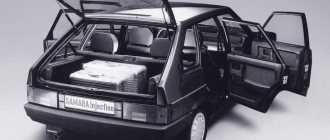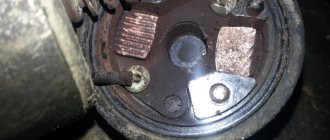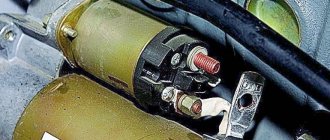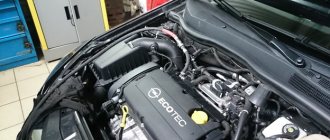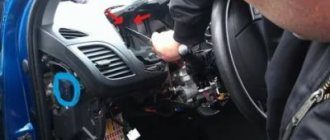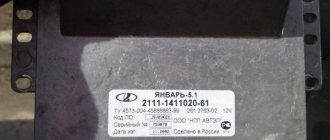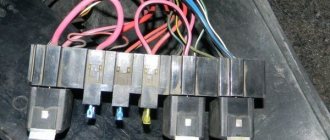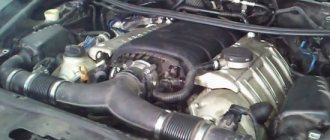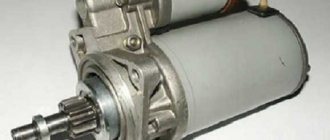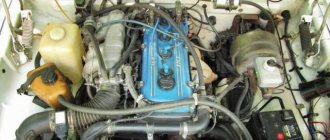This problem can be looked at in two ways. The spark may fail, or the ignition may fail, I’ll explain what I mean. The ignition circuit may be fine, but there is still no spark. That is, the coil can produce a spark, it is working properly and voltage comes to it, but the ignition has failed and there is no spark itself. Maybe the situation is different, the ignition is lost and, of course, there is no spark. The result in both cases is the same, but the approaches to troubleshooting are different. Let's look at them in order.
no spark:
— if in this case the ignition coil receives power, then the circuit to the coil is working;
— Next, you need to check the circuit from the ignition coil to the distributor, namely, see if low voltage comes to the distributor. This is checked when the ignition is turned on. We use a device or a light bulb to check whether there is power at the input to the distributor.
There is one feature here - the light will light only when the breaker contacts are open. With one caveat - if the entire distributor circuit is working properly, since if the light is on even when the contacts are closed, then the problem is in the contact group;
— check the contact pair of the distributor. If the circuit is working properly and the ignition is on, when the contacts open, the ignition coil should produce a spark;
If there is a spark when you manually open the contacts, but there is no spark when you turn the starter, then the contact group is to blame. And here again there may be several troubles:
- the contacts may be dirty or badly burnt, or have extreme wear.
- there may also be a difficult-to-find malfunction, which for some reason, based on experience, is not paid attention to. This is a crack in the plastic lining of the moving contact or its absence due to breakage. The lining serves to open the contacts at the moment of rotation of the distributor shaft, on which the cams are located (4 or 6 cams, depending on the number of cylinders). When the lining is cracked or broken off, the shaft cams cannot open the contacts and, as a result, there is no spark. In this case, the contact pair is replaced.
— if during the test the light comes on even with the contacts open or with the contacts closed, this indicates that the negative wire of the contact group is broken. It has no insulation and is not difficult to find for testing. To make sure that there is no minus on the contact pair, with the ignition on, you need to give a separate minus to the anvil of the contacts and open them - the coil should produce a spark. In this case, it is necessary to restore the negative wire or replace it. Now let's look at the case and what to do if the ignition fails. Read all this further on the topic.
Fuel system
If it is below -20 degrees outside the window, it is possible that condensation has formed in the tank. The presence of water in gasoline is a bad sign. Moreover, it is not necessary that it be “diluted” at the gas stations themselves. Due to the temperature difference, condensation forms on the walls of the tank. At low temperatures it freezes. As a result, the VAZ-2115 (injector, 8 valves) does not start. Frozen water can be both in the fuel lines and in the filter itself. There is no point in trying to turn the starter with the hope that the car is about to start. You'll just drain the battery. The only solution to the problem is to warm up the car. It's better if it's in a garage with this problem. By installing an oil or induction heater there, you will quickly warm up the air temperature in the room. And the car will start successfully.
Clogged filters
This problem can occur in both summer and winter. And this applies not only to the fuel filter, but also to the air filter. The latter is in a special plastic case. On VAZ 15th model cars it looks like this.
After moving the latches, lift the air filter housing cover and remove the cleaning element itself. If it is dirty, the part needs to be replaced. Filters are consumables and cannot be restored at home. Moreover, they cost pennies. As for the fuel filter, it is located under the bottom of the car. The element looks like in the photo below.
If the car has driven more than 30 thousand kilometers, the filter should be replaced. You will not be able to visually determine the degree of contamination as you can in the air. The part is located in a closed, non-separable case. It has porous paper inside. It is capable of passing particles smaller than 10 microns. Over time, the pores of the paper become clogged, and the filter is not able to pass the required amount of fuel through itself. So that the problem does not take you by surprise, change this part in advance.
A characteristic sign of failure is jerking when moving (as if the fuel supply to the cylinders had stopped for some time). This means that the submersible pump is not able to supply the required amount of fuel through the paper pores. As for the air filter, it is changed every 6 months or every 10 thousand kilometers. By following the regulations, you will protect yourself from such problems.
No spark VAZ 2109 injector Drive4U
Lada 2115 4 Unique Logbook Headlight hydrocorrector has run out
Camshaft and crankshaft position sensors. Replacing the timing belt, replacing the VAZ pump, replacing oil seals. Photo. A brief overview of camshaft and crankshaft position sensors. Camshaft and crankshaft position sensors. Replacing the timing belt, replacing the VAZ pump, replacing oil seals, replacing the alternator belt, How to change it yourself. There are probably no car owners left who do not know the purpose of the crankshaft position sensor. The VAZ 2109 injector crankshaft sensor is sometimes called a synchronization sensor, because it is thanks to it that the operation of the control unit is synchronized with the power unit. Replacing the timing belt, replacing the VAZ pump, replacing oil seals. What is an injector:
Fuel pump weight. Replacing the fuel pump for a VAZ 2109. Damn! Photo. This mass creates a lot of problems. If the bolt becomes loose, you will not be able to start the car. Fuel pump weight. Hatch cutout! Without removing the gas tank. Replacing the fuel pump for a VAZ 2109. Damn! What is an injector: operating principle and device? You will learn all this in our section. Fuel pump VAZ 2109 carburetor: appearance Removing the gasoline pump In this section we publish videos devoted to the principles of operation of the auto injector, and everything related to it.
Crash test of VAZ 2114 and VAZ2109, the results are shocking! Fuel pump weight. Photo. How wretched our auto industry is! Crash test of VAZ 2114 and VAZ2109, the results are shocking! This mass creates a lot of problems. If the bolt becomes loose, you will not be able to start the car. Fuel pump weight. What is an injector and what is the operating principle of the injection system? You will learn about all this in our section. In this category of the site you will find video materials devoted to the principles of operation and design of an auto injector, and everything related to it.
Coolant Temperature Sensor DTOZH Volkswagen Passat B3 and B4. Knock sensor. Malfunction of the knock sensor. VAZ. LADA. Photo. Coolant Temperature Sensor, also known as DTOZH, Volkswagen Passat B3 and B4 - protective screen. Coolant Temperature Sensor DTOZH Volkswagen Passat B3 and B4. Knock sensor. Malfunction of the knock sensor. Symptoms of faulty motor control on VAZ fuel-injected cars. Let's look at the main symptoms of a knock sensor failure and how to check its functionality. Warning: Do not try to pull out or push in the valve with your hands, this may damage the idle speed control. To do this, you need to use a diagnostic device or a special monitor.
Ignition coil. How to check the ignition coil. Checking the ignition coil directly on the car. Photo. How to check the ignition coil for functionality. Ignition coil. How to check the ignition coil. A car arrived with three cylinders, the cause of everything turned out to be the ignition coil. We are testing it. An important nuance. Infinity, in this case, can also mean no response from connecting the ohmmeter. In other words, if there was a number 1 on the device and it did not change when ringing, this is infinity. Checking the ignition coil directly on the car. What is an injector and what is the principle
How to solve a problem?
There are two ways to solve this problem:
- On the spot. If you don't have time to remove the spark plugs, you can try drying them directly in the engine. To do this, open the throttle valve 50 percent before starting. Fortunately, on the VAZ-2115 the accelerator pedal is mechanical, with a cable drive. This will allow more air to enter the combustion chamber. The candles are “blown out” automatically. After starting, the throttle valve can be closed. But this method is not always effective. And then the second method comes to the rescue.
- Self-drying. In this case, all four spark plugs are unscrewed. An important point - when removing armor wires, number each of them. Otherwise, the engine will not start at all, since the valve timing will be disrupted. You can quickly dry it with a home hairdryer, setting it to maximum blowing mode. If time permits, you can check the gaps between the electrodes of the spark plugs. When this parameter does not match the factory setting, the spark plug cannot produce a normal spark. We talk about this in more detail.
About spark plug gap
Over time, the gap between the electrodes increases. The normal parameter is from 0.7 mm to one millimeter. You can check this gap using a special feeler gauge.
The same is used for setting valve clearances on carburetor engines. So, if a parameter does not meet the norm, it should be adjusted. To do this, you should use a negative screwdriver. To reduce the gap, press the end of the plug onto the top electrode of the spark plug. With your other hand, hold the part itself. If you “overdid it”, it doesn’t matter – everything can be returned back. To do this, bend the electrode with the edge of a screwdriver (it bends quite easily) and check the distance again. It is worth noting that with a correctly set gap, you can not only ensure trouble-free engine starting, but also reduce fuel consumption by 5 percent. Also the car will run smoothly. After all, the mixture is ignited exactly at the moment when it is necessary. And the last thing is the resource of the candles themselves. If the gap is higher or lower than normal, the risk of breaking through the insulator increases significantly. As for the replacement schedule, it is about 40 thousand kilometers. It is recommended to replace the high-voltage wires along with the spark plugs.
Distributor
When looking for problems with the distributor, you need to take a close look at the inside of the cap. If there is damage, it should be replaced. If there are no problem areas, wash with gasoline. You can check the central contact of the distributor by moving it slightly to the side.
The integrity of the rotor insulation is easily checked by placing the central high-voltage wire at a distance of 5 mm from the rotor electrode and closing the breaker contacts with the ignition on. Sparks appearing in the gap mean that the rotor is not working and needs to be replaced.
Coil
Modern cars are no longer equipped with distributors. There is an ignition module here. VAZ-2115 (16 valves) is no exception. Sometimes breakdowns happen. Because of this, the VAZ-2115 does not start. The reasons are a faulty ignition distributor.
This item cannot be repaired. And in order not to waste time on diagnostics (or if you don’t have a multimeter), it’s worth installing a known-good ignition module. The VAZ-2115 should start without difficulty. Sometimes the high-voltage wires themselves pierce. But in this case the car starts and starts. This can be heard by the characteristic sound of the engine.
Bringing the car back to life
As for why a spark disappears, everything is probably very clear. Now, it would not be amiss to consider the order of her return. The reality is that in most cases, getting the spark back is a simple matter and just involves carefully checking the broken car. To be more precise, to normalize sparking it is required:
- Firstly, check the spark on the injector using the method described above, make sure that it has disappeared, and, at least indirectly, try to determine the cause of the malfunction;
- Next, it is enough to assess the current circumstances and act based on them. As typical situations, we suggest considering solutions to the following problems:
- the spark plug is wet, the presence and strength of the spark are unimportant, the carbon deposits are correct (brick color) - wipe the part and screw it back in;
- the spark plug is wet (not always) and the carbon deposits are incorrect (white or black) - clean, dry the part and try to start the engine, if there is no result, change the spark plug and deal with problems in the fuel system (cleaning the injector, checking the ECU, etc.);
- the spark plug is wet, there is no spark at all, the color of the soot is not important - we try to change the part, if there is no result, we check the ignition system and the operation of the injector.
In principle, in theory there are no particular difficulties in repairs of this kind. Despite this, it often causes difficulties in implementation for inexperienced motorists. To solve these, you need to act in the order described above, but if something doesn’t work out, it’s better to turn to professionals at a service station. This approach to repairs will not only save time, but also guarantee trouble-free operation of the car in the future.
Perhaps this concludes the most important information on today’s issue. We hope that the material presented was useful to you and provided answers to your questions. Good luck in operating and maintaining your car!
Malfunctions in the ignition system of the VAZ-2115 are always upsetting, because any of them leads to frequent malfunctions of the car’s engine. The main sign by which one can suspect a malfunction in the ignition system is weak caviar or its complete absence.
Relays and fuses VAZ-2115
It happens that the car does not start due to a banal failure of the fuses. In this case, the pump will not emit a characteristic hum when the ignition is turned on. The sound should come from under the rear seats. On VAZ-2115 cars the pump is submersible and is located directly in the fuel tank. If there is no hum in the first 3-5 seconds after turning on the ignition, it means that power is not supplied to the element.
We start looking for a break in the fuses. The cover indicates which one is responsible for the electric fuel pump. But not only fuses are checked. The VAZ-2115 is also equipped with a relay. This element should make characteristic clicks when the ignition is turned on. If the VAZ-2115 does not start and clicks are not heard, most likely the pump relay needs to be replaced. Sometimes cleaning contacts helps. For this purpose, special sprays in cans are used. For the future, it is worth purchasing a set of spare relays and fuses. Sometimes such a “childish” breakdown happens on the road. With new parts in stock, you can continue moving without hindrance.
High voltage wires
Next you need to visually check the high voltage wiring.
There should be no visible damage or disruption of the insulating layer. If the wiring is in good condition, you should check the wiring to the spark plugs. To do this, you need to remove the tip from the spark plug wire, bring it to a place on the body without paint and start the car. When the starter rotates, a bright spark with a bluish tint should appear. If this does not happen, you should check the ignition coil.
At the same time, the spark plugs do not fail. If there is a spark in the spark plug wiring, it is possible to check any of the glow plugs. To do this, you need to unscrew the suspicious spark plug from the block and put the spark plug wire on it. Next, you should touch the place on the body without paint with a metal part and, by rotating the starter, determine whether there is a spark or not.
Replacement of spark plugs must occur in a timely manner, in accordance with the maintenance of your car model. For VAZ-2115 - approximately every 20 thousand kilometers.
Ignition problems
Most often, the reason lies precisely in one component of the ignition system. Weaknesses that are the first to come under suspicion are:
- egnition lock;
- induction coils;
- starter and ignition relay;
- lack of voltage at the battery terminals.
Most often, the problem lies in a banal lack of voltage at the ignition switch contacts. It is supplied directly from the battery to the starter.
If, after turning the key, the dashboard goes out or does not light up at all, it may be a problem with the cylinder.
Checking the functionality of the ignition switch is relatively simple:
- it is necessary to dismantle the larva;
- Using a multimeter, the contacts are called in different positions.
If there is no contact, then you should simply purchase a new lock. It simply doesn't make sense to repair it.
You need to pay attention to the behavior of the car immediately after turning the key. If there is no characteristic clicking sound from the side of the door from under the panel, the relay has probably failed. It is located above the clutch pedal.
Like the ignition switch, it simply does not make sense to repair such a relay. You need to purchase a new one and install it in place. You also need to check the ignition coils. Often the spark on the spark plugs disappears due to their failure. The test must be carried out by removing the coil and connecting it to the tester. You should ring the windings - a break in one may be the cause of the malfunction.
If you have problems starting the engine in cold weather, you should make sure that the battery is working properly. Often it simply fails.
It is not difficult to check the condition of the battery using a conventional tester - you need to switch it to the constant voltage measurement mode and set it to the 20 V limit.
The voltage between the terminals should be 12.6 V. It would also be a good idea to measure the density of the electrolyte using a hydrometer.
How to check the ignition coil.
Lada Kalina Sedan my first car Logbook Phase sensor
Inspect this mechanism for oil stains and cracks. If the surface of the coil is not perfectly clean, wipe off the dirt with a dry cloth, otherwise it may cause high voltage leakage
Also pay attention to the ignition system wires; they must be dry and without external damage. Move the high-voltage wires with your hand and try to start the car
If this does not work, then you will have to check the ignition system more carefully. To diagnose the condition of the spark plugs, take two high-voltage wires, having first removed them from the distributor cap. Place the wires at a distance of 5-7 mm from the car engine and wait for the reaction. If the system is fully operational, then when the starter is cranked, a blue spark will appear in this gap. If there is no spark or a color other than blue, check the ignition coil.
The coil is checked in the same way. Remove the wire that goes from the coil to the distributor-breaker (distributor), and, by analogy with checking the spark plugs, with the starter running, bring the wire to the ground of the car. If there is no spark from the coil, then it is faulty. Connect the ignition coil to an ohmmeter to check for breaks in the wires. Check the primary and secondary windings. The absence of holes will be confirmed by the ohmmeter readings: 3 Ohms and 7000 Ohms in the primary and secondary windings, respectively. If the resistance is less than standard values, then you are most likely in danger of replacing the ignition coil.
Check the correct connection of the coil wires and its insulation. If the wires are tangled together, correct this by untangling them and positioning them correctly. Use an ammeter to check the current in the circuit. To do this, connect the contacts of the distributor and turn on the ignition. The current strength displayed by the device should not be higher than that set for your car. If the current value is greater than the standard value, it means that there is a break in the coil winding caused by a short circuit.
A malfunction in the operation of the ignition coil most often occurs when the ignition system is turned on when the engine is turned off. As a result, the insulation of high-voltage wires overheats, cracks, and crumbles over time, thus causing a short circuit.
If a faulty ignition coil is detected, it can be repaired or replaced with a new one. Repairing the ignition coil consists of separating the mechanism into parts; checking for cracks, chips, scratches; cleaning up damage; restoring the ideal surface of the shell by gluing them with a special compound.
Replacing the ignition coil with a new coil with exactly the same characteristics is possible. Connect the ignition coil with the utmost care, take special care to ensure the correct connection of the wires. Otherwise, the contacts may overheat and short circuit.
The appearance of a spark, correct readings of the ohmmeter and ammeter, indicate the serviceability of the unit being tested, and the breakdown of another component of the ignition system. The lack of a spark in the car system can also cause the following problem: the car does not start - the starter turns, there are cases when replacing the ignition switch helps.
Fuel supply: fuel pump failure and other reasons
If all of the above problems are absent, then you should check the performance of the fuel system. Often the reason lies in the following:
- the fuel pump has failed;
- low pressure level in the fuel line;
- the filter is clogged;
- the injectors are out of order;
- low pressure in the ramp.
You need to remember: it is quite difficult to check the performance of the fuel pump on cars with an injection engine. You can determine its performance by its sound - immediately after turning on the ignition, it should definitely make noise. If the fuel pump is faulty, it will need to be replaced. Such devices do not require repair.
You should check the pressure level in the fuel line and rail. To do this you will need to use a special pressure gauge. The normal pressure level for VAZ 2115 and VAZ 2114 is from 2 to 2.5 atm.
If this indicator is lower than specified, then the car will have poor grip and stall while driving. In this case, it will be difficult to fix the problem yourself. It is worth contacting a car service. It often leaks at the ramp connection point.
Basic information about the ignition system of a VAZ 2114 car
The VAZ 2114 brand car is built on the basis of the VAZ 21093 platform and is its improved version. There is a new steering wheel, an updated instrument panel, an adjustable steering column, a new heater and power windows. Changes related to the abandonment of the carburetor in the design of the VAZ 2114 car with an injection engine began to occur much later compared to foreign manufacturers, but these changes turned out to be quite useful.
On cars with an injection engine, the fuel mixture is supplied using a computer through special nozzles. Most likely, every car owner has ever encountered a problem when there is no spark on the high voltage wires, but the driver can hear how the fuel pump functions, then pay attention to the ignition system of your vehicle. One of the most common problems with a car's ignition system is that there is simply no spark at high voltage wiring.
During operation of the machine, some malfunctions of electrical components may occur and this may affect the functioning of:
- Instruments, and this does not make it possible to control the ignition system and other components;
- power unit, thereby making it impossible to develop standard power;
- Light fixtures and convenience mechanisms, which include lighting, heating and power windows.
The main breakdowns encountered by the ignition system of a VAZ 2114 car:
- Reduced vehicle power;
- Failure during the development of vehicle engine power;
- Idle speed instability;
- Violation of the normal functioning of the cylinder.
You need to start looking for the cause of malfunctions in the ignition system with the formation of sparks on high voltage wiring.
How does the spark formation process occur in a VAZ 2114 car?
If you hear the fuel pump operating, but there are no sparks on the high-voltage wiring, then check the functioning of the ignition system. The system is checked for the presence of sparks on high voltage wiring, and for this a special device called a spark gap is used. The use of this device is considered more comfortable, because most engines with an injector use static ignition distribution with simultaneous transmission of high voltage to two spark plugs.
Starter failure
If all other system components are in order, then the reason for the inability to start may lie in the absence of a starter. Typical problems:
- poor contact at the terminals;
- the starter shaft bearing has failed;
- The solenoid relay has stopped working.
It should be noted: the location of the power terminals on the starter suggests the presence of moisture. Therefore, often the contact simply oxidizes, which leads to problems in the operation of the device. That is why you need to carefully examine the contacts. Then clean them and check the voltage. If it is missing, there may be a break in the wiring.
When there is voltage, but the starter does not turn, it is often a problem with the bearings. To replace it, you will need a clean garage, as well as a special puller. This is the only way to dismantle it.
A little more often than a bearing, the solenoid relay fails. Sometimes it just jams - just tap it lightly with the key.
It is very simple to check the functionality of the retractor - just place the starter on the engine block and then touch the contact of the wiring relay connected to the positive terminal. If the starter starts spinning, it means the solenoid relay is in working condition. All of the problems listed above are typical and do not require any major repairs.
Low voltage circuit
Using a 12V lamp, you can check the low voltage circuit. The lamp must be connected with the first contact to the low voltage terminal, and the second to the car body. Next, you need to close the distributor contacts and start the ignition. If the circuit is OK, the lamp will light when the contacts open and go out when the contacts close.
If the lamp does not light up when the contacts are opened, this means that the problem is in the low voltage wiring or in the ignition coil, or rather, in its winding.
Other reasons for the inability to start the engine
Figuring out why the engine stalls is not difficult. In addition to typical problems, the following types of problems may be present:
- timing belt is broken;
- the engine “knocked”;
- the shaft is jammed.
A fairly common problem, especially on 16-valve engines, is a broken timing belt. In this case, the valves on the VAZ 2115 bend. Such breakdowns not only lead to the inability to start the engine. But they require a complete engine overhaul. The situation is similar if the engine knocks. If you can’t start the car even when it’s hot, you should check the air supply channel. Moreover, starting is not always possible the first time.
There are many nuances associated with setting the ignition and ensuring normal engine operation. You will need to carefully understand all the subtleties and nuances. Many problems associated with the inability to start the VAZ 2115 engine are associated with typical malfunctions and repairs take a minimum of time.
Source
What to do if there is no spark VAZ-2109 carburetor reasons
The reasons why the spark disappears on a VAZ-2109 carburetor type car may be the following:
- faulty Hall sensor;
- the switch burned out;
- break in the ignition coil;
- high-voltage wires are worn out;
- the candles became unusable;
- The timing belt is worn.
From the very beginning, if the disappearance of the spark is detected, you should review all contacts and the condition of the electrical wiring. If you find oxidation on the connector, it must be cleaned with sandpaper and rechecked for the presence of a spark. High-voltage wires should be checked for integrity using a special device - a tester.
A breakdown in the ignition switch can be diagnosed using a standard automotive lamp. One of its contacts must be connected to the body body or carburetor engine 2109, and the second contact must be connected to wire “B+” from the ignition coil. If the light is on, this indicates that the ignition switch is working properly. In this case, you need to go to the ignition coil.
The serviceability of the Hall sensor can be checked using a voltmeter or, again, a light bulb. At the moment the distributor rotates, the filament in the light bulb should change the intensity of the glow.
The simplest way to check for proper ignition of carburetor VAZ-2109
If there is no spark in the car, you can find the reasons in another way. This technique does not require the use of a special device or tool. In this method, the entire ignition chain is tested, without taking into account the Hall sensor. To carry out this work, we need a small wire with insulated ends and a nail or paper clip.
First of all, we disconnect the high-voltage cable from the distributor. During checking, it must be positioned approximately 10 millimeters from the minus of the car. Next, turn on the ignition. Disconnect the connector from the Hall sensor and connect its end to the middle contact, to which the green wire is connected. We short the other end of our wire several times to ground. At the moment of short circuit, sparks should run between the ground and the end of the wire. If there is a spark in a carburetor VAZ-2109, we can conclude that the Hall sensor is faulty or there is no contact. Often, inside the distributor itself, the plate frays the wires or the connector simply becomes loose. In addition, there are cases when, when checking, we see the presence of a spark, but when connecting the wire to the spark plug caps, there is no spark. This indicates the need to replace the slider inside the distributor. Some carburetor-type VAZ-2109 are equipped with an ignition interlock circuit, which may also become unusable (or there is a malfunction in the switch).
Before performing the test, you need to prepare the following set of tools:
- figured and flat screwdrivers;
- insulated pliers;
- control with a wire or tester;
- spare spark plug.
To protect yourself from electric shock, you should wear dielectric gloves.
Verification process:
- We turn off the ignition, after which we check the high-voltage wires for breaks, and at the same time check for good contact in the connections with the distributor and the ignition coil.
- We carefully inspect the condition of the wires between the distributor and the switch, and also check the wires from the ignition coil to the switch.
- With the ignition switch on on a carburetor VAZ-2109, you need to check the presence of power in the system. To do this, take a test lamp, connect one end to ground, and the other to the “B+” contact of the coil. The glow of the control lamp indicates the presence of power.
- Using a rubber glove, disconnect the middle high-voltage wire from the distributor. We put a spark plug into its tip and touch the engine ground with the metal part. When cranking the starter, sparks should flow from the spark plug.
- Unscrew the screws of the distributor and remove its cover. We check for cracks and damage, and also check the condition of the coal. If the cover is damaged or cracked, it must be replaced.
- We inspect the condition of the slider in the distributor. Quite often it happens when there is no spark due to a breakdown of the interference suppression relay or breakdowns in the housing of the ground slider.
- We check the crankshaft by rotating the starter. If the slider is stationary, the reason for this is a broken timing belt or the drive itself is faulty.
- We check again for the presence of a spark.
- If once again there is no spark in a VAZ-2109 carburetor type car, you should check the high-voltage ignition wiring, as well as the spark plugs themselves. To do this, you must use a known good spark plug. If there is still no spark, change the high-voltage wire.
